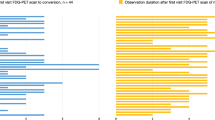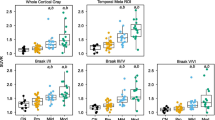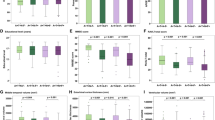Abstract
Purpose
The aim of this study was to examine the value of fluorodeoxyglucose (FDG) positron emission tomography (PET) in predicting subsequent rates of functional and cognitive decline among subjects considered cognitively normal (CN) or clinically diagnosed with mild cognitive impairment (MCI).
Methods
Analyses of 276 subjects, 92 CN subjects and 184 with MCI, who were enrolled in the Alzheimer’s Disease Neuroimaging Initiative, were conducted. Functional decline was assessed using scores on the Functional Activities Questionnaire (FAQ) obtained over a period of 36 months, while cognitive decline was determined using the Alzheimer’s disease Assessment Scale-Cognitive subscale (ADAS-Cog) and Mini-Mental State Examination (MMSE) scores. PET images were analyzed using clinically routine brain quantification software. A dementia prognosis index (DPI), derived from a ratio of uptake values in regions of interest known to be hypometabolic in Alzheimer’s disease to regions known to be stable, was generated for each baseline FDG-PET scan. The DPI was correlated with change in scores on the neuropsychological examinations to examine the predictive value of baseline FDG-PET.
Results
DPI powerfully predicted rate of functional decline among MCI patients (t = 5.75, p < 1.0E-8) and pooled N + MCI patient groups (t = 7.02, p < 1.0E-11). Rate of cognitive decline on MMSE was also predicted by the DPI among MCI (t = 6.96, p < 1.0E-10) and pooled N + MCI (t = 8.78, p < 5.0E-16). Rate of cognitive decline on ADAS-cog was powerfully predicted by the DPI alone among N (p < 0.001), MCI (t = 6.46, p < 1.0E-9) and for pooled N + MCI (t = 8.85, p = 1.1E-16).
Conclusions
These findings suggest that an index, derivable from automated regional analysis of brain PET scans, can be used to help predict rates of functional and cognitive deterioration in the years following baseline PET.




Similar content being viewed by others
References
Association As. 2016 Alzheimer’s disease facts and figures. Alzheimers Dement. 2016;12:459–509.
Eshkoor SA, Hamid TA, Mun CY, Ng CK. Mild cognitive impairment and its management in older people. Clin Interv Aging. 2015;10:687–93. doi:10.2147/CIA.S73922.
Busse A, Angermeyer MC, Riedel-Heller SG. Progression of mild cognitive impairment to dementia: a challenge to current thinking; 2006.
Sperling RA, Aisen PS, Beckett LA, Bennett DA, Craft S, Fagan AM, et al. Toward defining the preclinical stages of Alzheimer’s disease: Recommendations from the National Institute on Aging-Alzheimer’s Association workgroups on diagnostic guidelines for Alzheimer’s disease. Alzheimers Dement: J Alzheimers Assoc. 2011;7:280–92. doi:10.1016/j.jalz.2011.03.003.
Ishii K. PET approaches for diagnosis of dementia. Am J Neuroradiol. 2014;35:2030–8. doi:10.3174/ajnr.A3695.
Silverman DS, Small GW, Chang CY, et al. Positron emission tomography in evaluation of dementia: Regional brain metabolism and long-term outcome. JAMA. 2001;286:2120–7. doi:10.1001/jama.286.17.2120.
Minoshima S, Giordani B, Berent S, Frey KA, Foster NL, Kuhl DE. Metabolic reduction in the posterior cingulate cortex in very early Alzheimer’s disease. Ann Neurol. 1997;42:85–94. doi:10.1002/ana.410420114.
Pfeffer RI, Kurosaki TT, Harrah Jr CH, Chance JM, Filos S. Measurement of functional activities in older adults in the community. J Gerontol. 1982;37:323–9.
Rosen WG, Mohs RC, Davis KL. A new rating scale for Alzheimer’s disease. Am J Psychiatry. 1984;141:1356–64.
Folstein MF, Folstein SE, McHugh PR. “Mini-mental state”: A practical method for grading the cognitive state of patients for the clinician. J Psychiatr Res. 1975;12:189–98. doi:10.1016/0022-3956(75)90026-6.
Friston KJ, Holmes AP, Worsley KJ, Poline JP, Frith CD, Frackowiak RSJ. Statistical parametric maps in functional imaging: a general linear approach. Hum Brain Mapp. 1994;2:189–210. doi:10.1002/hbm.460020402.
Friston KJ, Ashburner J, Frith CD, Poline JB, Heather JD, Frackowiak RSJ. Spatial registration and normalization of images. Hum Brain Mapp. 1995;3:165–89. doi:10.1002/hbm.460030303.
Ashburner J, Barnes G, Chen C. SPM8 manual Wellcome Trust Centre for Neuroimaging 1-475.
Talairach J, Tournoux P. Co-planar stereotaxic atlas of the human brain. Thieme Medical Publishers
Lindbergh CA, Dishman RK, Miller LS. Functional disability in mild cognitive impairment: a systematic review and meta-analysis. Neuropsychol Rev. 2016;26:129–59. doi:10.1007/s11065-016-9321-5.
Roy K, Pepin LC, Philiossaint M, Lorius N, Becker JA, Locascio JJ, et al. Regional fluorodeoxyglucose metabolism and instrumental activities of daily living across the Alzheimer’s disease spectrum. J Alzheimers Dis : JAD. 2014;42:291–300. doi:10.3233/JAD-131796.
Ishii K. Clinical application of positron emission tomography for diagnosis of dementia. Ann Nucl Med. 2002;16:515–25. doi:10.1007/BF02988628.
Brown RKJ, Bohnen NI, Wong KK, Minoshima S, Frey KA. Brain PET in suspected dementia: patterns of altered FDG metabolism. RadioGraphics. 2014;34:684–701. doi:10.1148/rg.343135065.
Kato T, Inui Y, Nakamura A, Ito K. Brain fluorodeoxyglucose (FDG) PET in dementia. Ageing Res Rev. 2016;30:73–84. doi:10.1016/j.arr.2016.02.003.
Berti V, Mosconi L, Pupi A. Brain: normal variations and benign findings in FDG PET/CT imaging. PET Clin. 2014;9:129–40. doi:10.1016/j.cpet.2013.10.006.
Pardo JV, Lee JT, Sheikh SA, Surerus-Johnson C, Shah H, Munch KR, et al. Where the brain grows old: decline in anterior cingulate and medial prefrontal function with normal aging. NeuroImage. 2007;35:1231–7. doi:10.1016/j.neuroimage.2006.12.044.
Kakimoto A, Ito S, Okada H, Nishizawa S, Minoshima S, Ouchi Y. Age-related sex-specific changes in brain metabolism and morphology. J Nucl Med. 2016;57:221–5. doi:10.2967/jnumed.115.166439.
Ewers M, Brendel M, Rizk-Jackson A, Rominger A, Bartenstein P, Schuff N, et al. Reduced FDG-PET brain metabolism and executive function predict clinical progression in elderly healthy subjects. NeuroImage : Clinical. 2014;4:45–52. doi:10.1016/j.nicl.2013.10.018.
Rizk-Jackson A, Insel P, Petersen R, Aisen P, Jack C, Weiner M. Early indications of future cognitive decline: stable versus declining controls. PLoS One. 2013;8:e74062. doi:10.1371/journal.pone.0074062.
Drzezga A, Lautenschlager N, Siebner H, Riemenschneider M, Willoch F, Minoshima S, et al. Cerebral metabolic changes accompanying conversion of mild cognitive impairment into Alzheimer’s disease: a PET follow-up study. Eur J Nucl Med Mol Imaging. 2003;30:1104–13. doi:10.1007/s00259-003-1194-1.
Cerami C, Della Rosa PA, Magnani G, Santangelo R, Marcone A, Cappa SF, et al. Brain metabolic maps in mild cognitive impairment predict heterogeneity of progression to dementia. NeuroImage: Clinical. 2015;7:187–94. doi:10.1016/j.nicl.2014.12.004.
Zhang S, Han D, Tan X, Feng J, Guo Y, Ding Y. Diagnostic accuracy of 18F-FDG and 11C-PIB-PET for prediction of short-term conversion to Alzheimer’s disease in subjects with mild cognitive impairment. Int J Clin Pract. 2012;66:185–98. doi:10.1111/j.1742-1241.2011.02845.x.
Chen K, Ayutyanont N, Langbaum JBS, Fleisher AS, Reschke C, Lee W, et al. Characterizing Alzheimer’s disease using a hypometabolic convergence index. NeuroImage. 2011;56:52–60. doi:10.1016/j.neuroimage.2011.01.049.
Landau SM, Harvey D, Madison CM, Koeppe RA, Reiman EM, Foster NL, et al. Associations between cognitive, functional, and FDG-PET measures of decline in AD and MCI. Neurobiol Aging. 2011;32:1207–18. doi:10.1016/j.neurobiolaging.2009.07.002.
Mallik A, Drzezga A, Minoshima S. Clinical amyloid imaging. Semin Nucl Med. 2017;47:31–43. doi:10.1053/j.semnuclmed.2016.09.005.
Okamura N, Harada R, Furukawa K, Furumoto S, Tago T, Yanai K, et al. Advances in the development of tau PET radiotracers and their clinical applications. Ageing Res Rev. 2016;30:107–13. doi:10.1016/j.arr.2015.12.010.
Marzanski M. On telling the truth to patients with dementia. West J Med. 2000;173:318–23.
Elson P. Do older adults presenting with memory complaints wish to be told if later diagnosed with Alzheimer’s disease? Int J Geriatr Psychiatry. 2006;21:419–25. doi:10.1002/gps.1485.
Alzheimer’s A. 2015 Alzheimer’s disease facts and figures. Alzheimers Dement. 2015;11:332–84.
Petersen RC, Doody R, Kurz A, et al. Current concepts in mild cognitive impairment. Arch Neurol. 2001;58:1985–92. doi:10.1001/archneur.58.12.1985.
Acknowledgments
Data collection and sharing for this project was funded by the Alzheimer’s Disease Neuroimaging Initiative (ADNI) (National Institutes of Health Grant U01 AG024904) and DOD ADNI (Department of Defense award number W81XWH-12-2-0012). ADNI is funded by the National Institute on Aging, the National Institute of Biomedical Imaging and Bioengineering, and through generous contributions from the following: AbbVie, Alzheimer’s Association; Alzheimer’s Drug Discovery Foundation; Araclon Biotech; BioClinica, Inc.; Biogen; Bristol-Myers Squibb Company; CereSpir, Inc.; Eisai Inc.; Elan Pharmaceuticals, Inc.; Eli Lilly and Company; EuroImmun; F. Hoffmann-La Roche Ltd and its affiliated company Genentech, Inc.; Fujirebio; GE Healthcare; IXICO Ltd.; Janssen Alzheimer Immunotherapy Research & Development, LLC.; Johnson & Johnson Pharmaceutical Research & Development LLC.; Lumosity; Lundbeck; Merck & Co., Inc.; Meso Scale Diagnostics, LLC.; NeuroRx Research; Neurotrack Technologies; Novartis Pharmaceuticals Corporation; Pfizer Inc.; Piramal Imaging; Servier; Takeda Pharmaceutical Company; and Transition Therapeutics. The Canadian Institutes of Health Research is providing funds to support ADNI clinical sites in Canada. Private sector contributions are facilitated by the Foundation for the National Institutes of Health (www.fnih.org). The grantee organization is the Northern California Institute for Research and Education, and the study is coordinated by the Alzheimer’s Disease Cooperative Study at the University of California, San Diego. ADNI data are disseminated by the Laboratory for Neuro Imaging at the University of Southern California.
Author information
Authors and Affiliations
Consortia
Corresponding author
Ethics declarations
Conflict of interest
The authors declare that they have no conflicts of interest.
All procedures performed in studies involving human participants were in accordance with the ethical standards of the institutional and/or national research committee and with the 1964 Helsinki Declaration and its later amendments or comparable ethical standards.
Informed consent
Informed consent was obtained from all individual participants included in the study by ADNI.
Additional information
Data used in preparation of this article were obtained from the Alzheimer’s Disease Neuroimaging Initiative (ADNI) database (Adni.loni.usc.edu). As such, the investigators within the ADNI contributed to the design and implementation of ADNI and/or provided data but did not participate in analysis or writing of this report. A complete listing of ADNI investigators can be found at: http://adni.loni.usc.edu/wp-content/uploads/how_to_apply/ADNI_Acknowledgement_List.pdf
Rights and permissions
About this article
Cite this article
Torosyan, N., Mason, K., Dahlbom, M. et al. Value of FDG-PET scans of non-demented patients in predicting rates of future cognitive and functional decline. Eur J Nucl Med Mol Imaging 44, 1355–1363 (2017). https://doi.org/10.1007/s00259-017-3634-3
Received:
Accepted:
Published:
Issue Date:
DOI: https://doi.org/10.1007/s00259-017-3634-3




